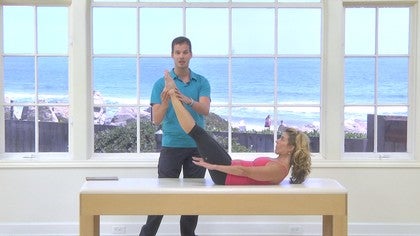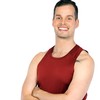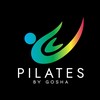The Hundred
Benjamin Degenhardt
Tutorial 1770
Watch this Tutorial
Thanks again everyone - I am beyond thrilled that this tutorial inspired you to explore this exercise anew. I truly believe it sets the foundation for a strong practice. Keep the questions coming!
8 years ago
Mary - I personally don't believe in "right" or "wrong", but I am so happy that you asked this question. I'd love for you to practice the exercise with the arms pumping at the traditionally "prescribed" height a few times and then report back here with the differences you notice: how does it affect the movement? Is it harder, easier, how does it feel to you? Then we'll compare notes!
8 years ago
I'll never look at the Hundred the same way ever again. Thank you so much for your thoughtful explanation!
8 years ago
I know I commented already yesterday... but since I watched this video I've been really meditating on this way of practicing the Hundred and I'm noticing that every other exercise that I and my clients practice are much more connected after practicing the Hundred this way. This is feeding a craving I already had to learn more about how Joseph Pilates originally practiced and taught. Benjamin, are you willing to post some references so that I can do some of my own reading? His book doesn't always explain the why's of things and I'm so curious to know if there are any books with deeper explanations? (Also...not to answer Mary's question for her, but I feel my neck release and my collar bone widen with my arms higher over the hips rather than down by the sides. I like this sensation much better and plan to practice the Hundred this way from now on!)
8 years ago
Thank you so much Jeri Ann! I love that you observed how The Hundred—done according to the original instructions—sets you up for success in the other exercises. Despite the difficulty of executing it this way, it programs the body for that deep central body control we need in all the exercises that follow. Most modifications commonly taught today still yield great benefits, but in my experience they often fail to fulfill this purpose.
After years of extensive research into the "why's" behind the work I can say that Joseph Pilates was decidedly vague about the desired outcome of any one exercise; they are all pieces of a bigger, systematic puzzle and strive to accomplish something other than toning or stretching certain muscles or body parts. They all serve the greater goal of better movement in everyday life and improved physical health. And about this, he was quite vocal indeed.
After years of extensive research into the "why's" behind the work I can say that Joseph Pilates was decidedly vague about the desired outcome of any one exercise; they are all pieces of a bigger, systematic puzzle and strive to accomplish something other than toning or stretching certain muscles or body parts. They all serve the greater goal of better movement in everyday life and improved physical health. And about this, he was quite vocal indeed.
8 years ago
As for resources, the information about Joseph Pilates’ thought-process is scattered across various essays, letters, interviews, as well as photography and video footage. Unfortunately there is not a comprehensive text that puts it all together (I am working on it), but a great place to start is an original essay about Contrology from 1957. It was recently reprinted and made available, you can find it by searching for the ‘Pilates Pamphlet’ on ebay.com.
Also feel free to consult my website, and the blog specifically, to learn more about my interpretation of archival materials, exercises, and more: benjamindegenhardt.com
Also feel free to consult my website, and the blog specifically, to learn more about my interpretation of archival materials, exercises, and more: benjamindegenhardt.com
8 years ago
Thank you so much for all of your insight! I will definitely look into this essay and I look forward to digging deeper into your interpretations as well. I'll keep looking for you on PA! I've enjoyed all of your videos so far... they have all been so informative and inspiring to me,
8 years ago
11-20 of 40
You need to be a subscriber to post a comment.
Please Log In or Create an Account to start your free trial.























I have a question about the placement of the arms.
Why did Joseph Pilates want the arms 5-6" above the hips?
I have been teaching this exercise with the arms hip level... is this wrong?